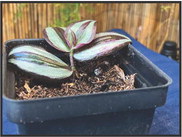Boost Your Indoor Garden’s Beauty


Whether your indoor garden has outgrown its location or you are looking to expand your garden, a bit of pinching, pruning or propagating may be the answer. Grooming houseplants keeps y...


Whether your indoor garden has outgrown its location or you are looking to expand your garden, a bit of pinching, pruning or propagating may be the answer. Grooming houseplants keeps y...